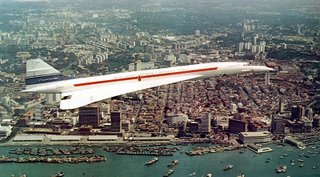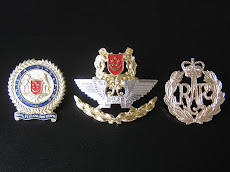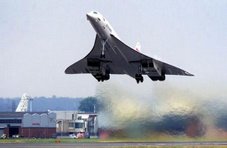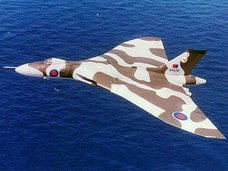>> Concorde: Golden age of supersonic travel

by Derek Yeo - SINGAPORE - 22 October 2006
IN MARCH 2006, while on my way to the departure terminal at Charles de Gaulle (CDG) Airport in
A graceful airplane indeed, even as it stood grounded on its pedestal!
That chance encounter with Concorde rekindled my memories of Concorde's first visit to Singapore. On 7 June 1972, British Aircraft Corporation prototype 002 (G-BSST) - landed at 1700 hours at Paya Lebar Airport after a stop-over in Bangkok.
The photo above shows G-BSST flying past the Singapore waterfront on its approach to Paya Lebar Airport during the historic flight. Captained by test pilot Brian Trubshaw, the supersonic jet had lifted off from Heathrow Airport, London just nine hours earlier.
From a vantage point in a packed arrival lounge, I watched it taxied in to a rousing lion-dance welcome by an enthusiastic reception party. Concorde 002, resplendent in a glossy white-blue-red livery, sitting on the crowded tarmac was just in a word: magnificent.
Since their retirement, hardly anything was heard of them. Of the original 20 built between 1966 and 1979, 14 flew passenger services with Air France and British Airways before retirement hastened by the tragic crash of Concorde F-BTSC on 25 July 2000.
Four prototype jets were built: two each in Britain and France. Production of the jets were shared equally between both countries. The first production aircraft in each country - used for airworthiness certification, promotion, airline training and route-proving flights - did not enter airline service.The remaining fleet of Concordes is dispersed in several countries. Many, preserved and protected from the elements, survived as museum exhibits or on display stands at airports. In preserving, upkeeping and displaying the retired planes, both AF and BA did their utmost to ensure the legendary Concorde would be remembered always. But in this respect, Air France seemed to be better organised with its five aircraft.
Today, the status of the fleet as it is:
MSN - REGISTRATION - AIRLINE - FLIGHT HOURS - CURRENT LOCATION
001 - F:WTSS - AS/BAC - 812 - French Air Museum, Le Bourget - Paris
002 - G:BSST - BAC/SA - 836 - RNAS Yeovilton, Somerset
101 - G:AXDN - BAC/Asp - 575 - Imperial War Museum, Duxford, Cambridgeshire
102 - F:WTSA - BAC/Asp - 656 - Orly Airport, Paris
201 - F:WTSB - Asp/BAC - 909 - Aerospatiale HQ, Toulouse, France
202 - G:BBDG - BAC/Asp - 1,282 - Brooklands Museum, Weybridge
203 - F:BTSC - AF - 11,989 - Crashed on July 25, 2000, remains kept at Le Bourget
204 - G:BOAC - BA - 22,260 - Manchester Airport, England
205 - F:BVFA - AF - 17,824 - Smithsonian Museum's Steven F. Udvar-Hazy Center, Dulles Airport, Washington DC, USA206 - G:BOAA - BA - 22,786 - Museum of Flight, East Fortune airfield, Edinburgh
207 - F:BVFB - AF - 14,771 - Sinsheim Auto und Technik Museum, SW Germany. Displayed besides Russian Tupolev Tu-144.
208 - G:BOAB - BA - 22,297 - Heathrow Airport, London - beside runway 23
209 - F:BVFC - AF - 14,332 - Airbus factory, Toulouse, France
210 - G:BOAD - BA - 23,397 - Intrepid Sea Air & Space Museum, New York
211 - F:BVFD - AF - 5,821 - Retired 27 May 1982, scrapped 1994, fuselage stored at Le Bourget
212 - G:BOAE - BA - 23,376 - Grantley Adams Airport, Barbados, West Indies
213 - F:BTSD - AF - 12,974 - Le Bourget Air & Space Museum, Paris, France
214 - G:BOAG - BA - 16,239 - Museum of Flight, Boeing Field, Seattle, USA
215 - F:BVFF - AF - 12,420 - Paris CDG Airport, France
216 - G:BOAF - BA - 18,257 - Filton airfield, Bristol, England. It flew the last flight by a Concorde. UK Concorde preservation body is planning to keep this plane airworthy. Plans are in progress for its permanent indoor display at a new aviation heritage centre in Filton.
No passenger jet could match Concorde. In design, power and speed, it marked the pinnacle of man's endeavours in the history of civil aviation.
Concorde's service ended in 2003, symbolised poignantly by the majestic aeroplane grounded at Paris CDG airport. It ended too, the romance of supersonic passenger travel in unsurpassed comfort and style.
For the discerning air traveller, it was an illustrious aerial career shortened far too soon.
Copyright © 2007 AIRMENews. All rights reserved.




